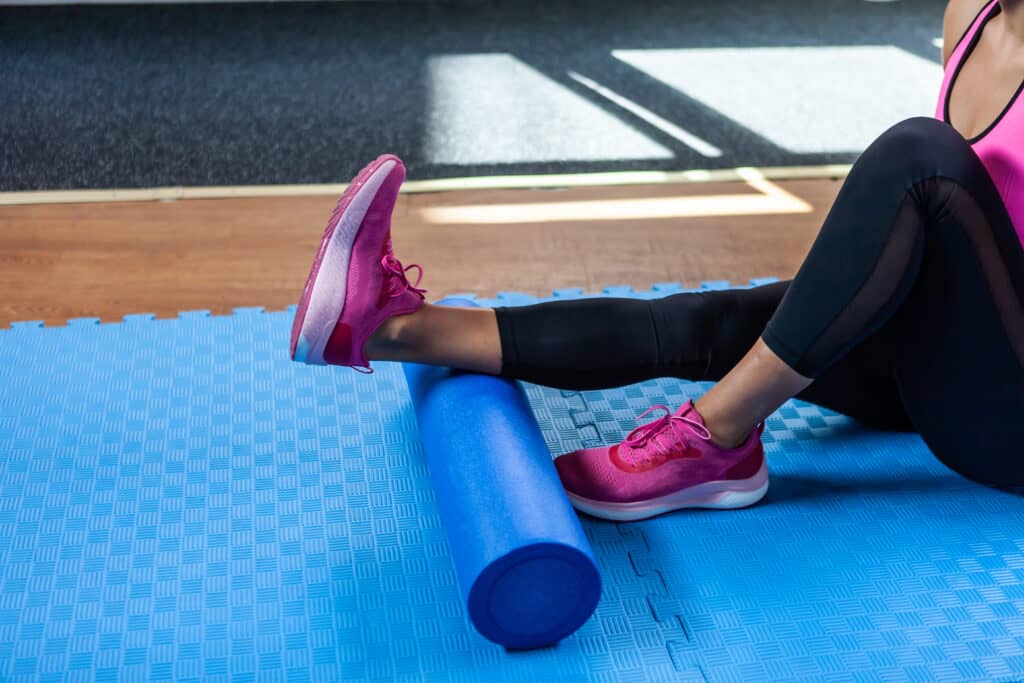You can find one in every gym. The majority of people, though, never seem to take advantage of it. We are talking about a foam roller. One of the least expensive and most beneficial exercise recovery tools you can use. There is plenty of scientific evidence showing the benefits is used on a regular basis. Here are just a few research papers showing the value of foam rolling.
In this article we’re going to look at one specific area of the body that can really benefit from foam rolling. Just a few minutes of “rolling out” the lower leg, each day, can decrease pain, improve range of motion and performance. Many of us experience restricted range of motion in the posterior lower leg. When left untreated, one can end up with calf strains and achilles tendon issues. Prevention is the best medicine for the lower leg as well as other areas of the body. Add foam rolling as part of your warm-up or cool-down and make it a “must do” before any exercise or strength training workouts. Read this article from Jefit, on how to properly use a foam roller.
Lower Leg: Steps for Using a Foam Roller
As with any part of the body that you foam roll, it’s important to understand the action of the muscle group you’re working on. In addition, understanding where the muscle is located as well as the origin and insertion of the tendons will also help. This way, you can target all of that muscle and surrounding connective tissue.
Step 1
Begin in a seated position on the floor with the foam roller resting on the backside of your lower leg. Roll out the belly of the calf muscle. Next, turn the leg slightly to the left and right to target additional lower leg muscles, as you continue to roll out. Don’t forget to move down the length of the achilles tendon. You can begin by rolling out both legs initially, before moving to each individual side. As you rollover any tight areas, pause for 30-60 seconds, and just breath. For each tight tight area, spend time resting and “breath into” those tight areas, before moving to another part of the lower leg.
Step 2
Once the back of the lower leg is completely rolled out, move to the front side of the lower leg. To get at this area, position your self on your hands and knees. You can either keep the arms straight or eventually move to resting on the forearms. Next, straighten out one leg while keeping the other as is (bent). The front lower leg should be resting on the foam roller. The goal is to work or roll out the length of the entire lower leg. Move back and forth from just below the knee to the foot.
Step 3
Once the front and back of the lower leg is done, move to the foot. For the foot, put the foam roller aside and use either a tennis, golf or lacrosse ball. Try each one to help determine which one you prefer. I personally like a golf ball, which can get into some of those smaller, tighter areas of the foot. The fascia on the bottom of the foot can be sensitive for a lot of people. The term fascia has previously been described as “the soft-tissue component of the connective tissue system that permeates the human body, forming a continuous, whole-body, three-dimensional matrix of structural support.”
From a seated position, you can work the entire length of the foot, moving the ball back and forth. Give the area right before the heel as well as the front of the foot a lot of love. Really get into those small areas trying to find any tight, restrictive tissue. As you come across such areas, simply stay put on those areas, not moving, just breathing and relaxing the rest of your body. Hold for 30-90 seconds to release any tight connective tissue, before moving on.
Final Thoughts
Applying these three steps on a daily or even every other day basis, will help reduce the occurrence of future calf or foot issues. The last thing you want is to have to stay out of the gym because you can’t put any pressure on your foot. Again, prevention is truly the best medicine for things like this. Think about adding foam rolling into your warm-up or cool-down to help cover all the bases. Foam rolling is extremely beneficial, especially before any exercise or strength training workout.
Stay Strong Together
The Jefit community is responsible for more than 92,000,000 workouts to date! The app, which recently passed 12 million downloads, comes equipped with an advanced customizable workout planner and training log. The app also has ability to track data, offer audio coaching cues, and can share workouts with friends. Visit our members-only Facebook group. Connect with like-minded people, share tips, and advice to help get closer to reaching your fitness goals.
